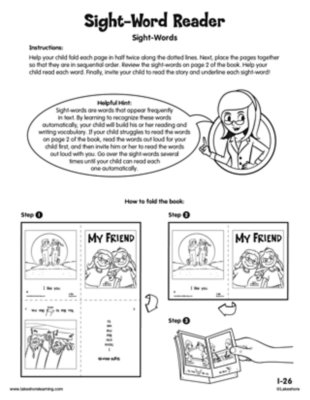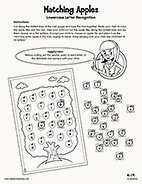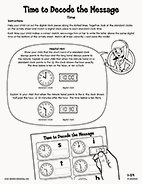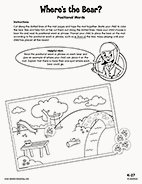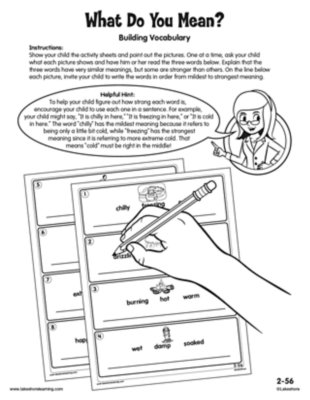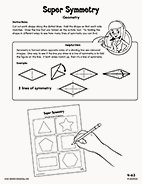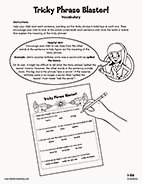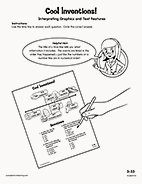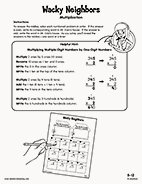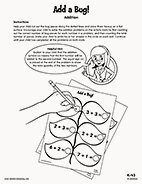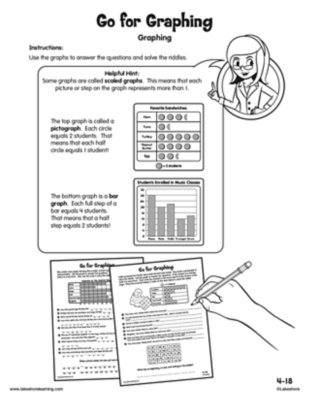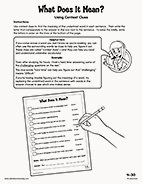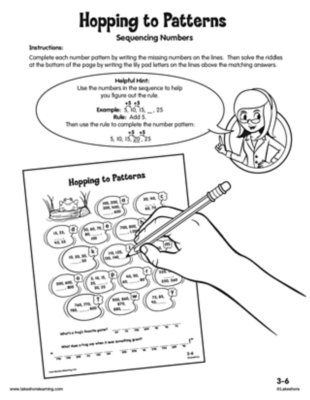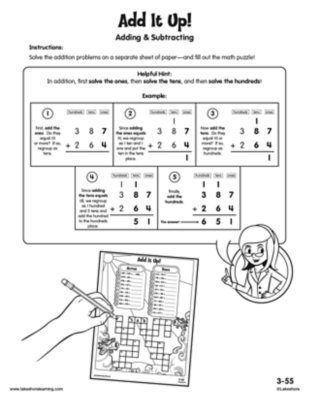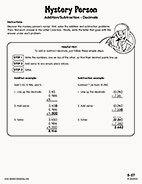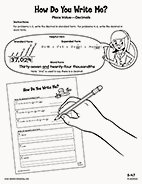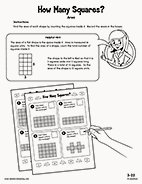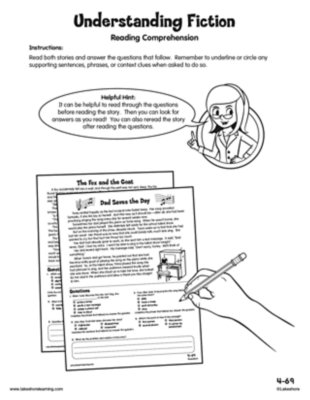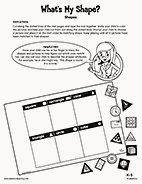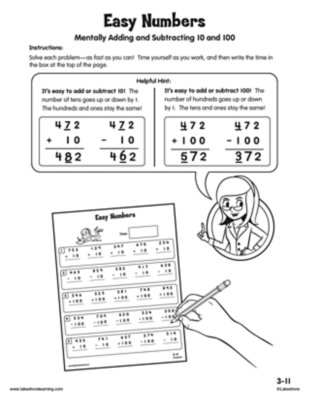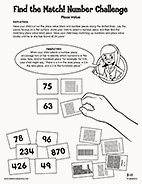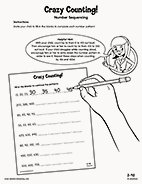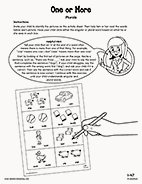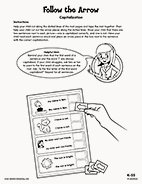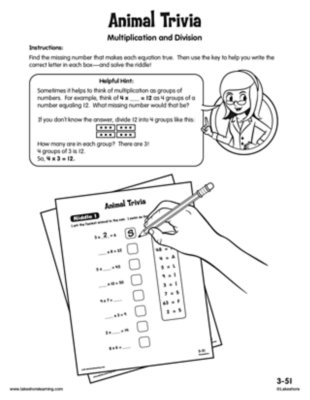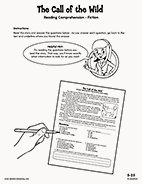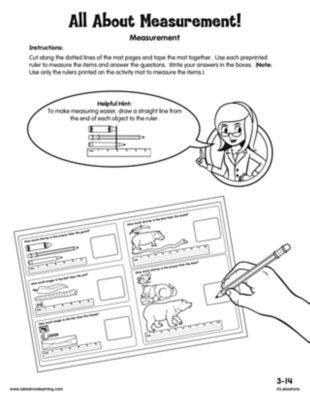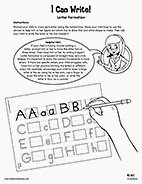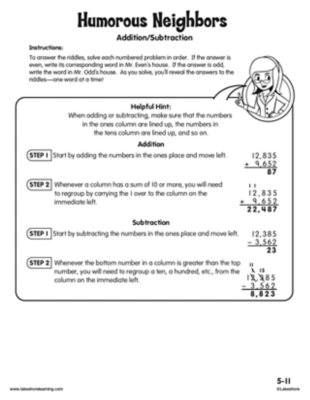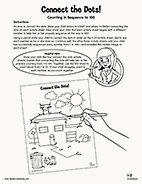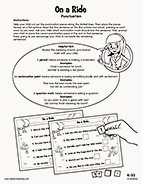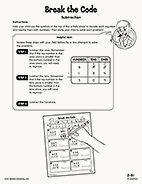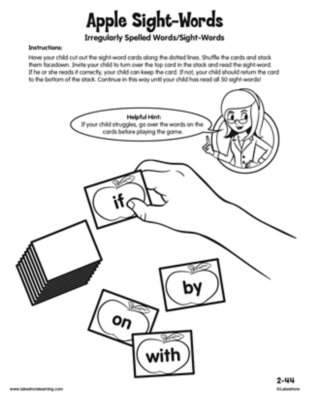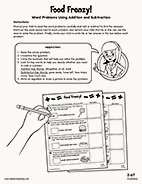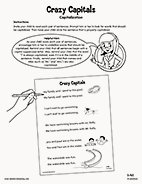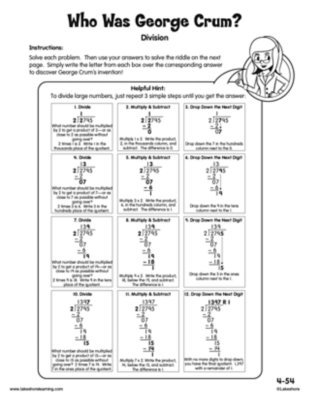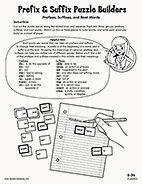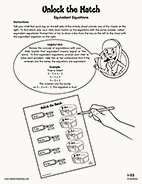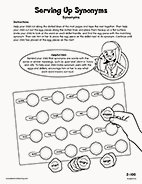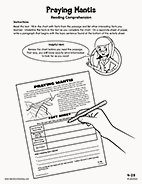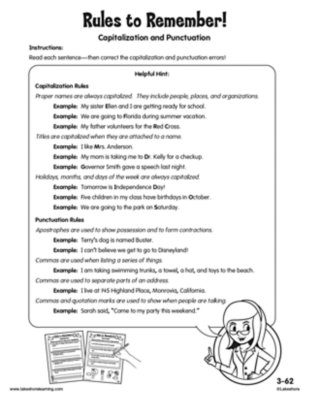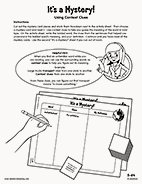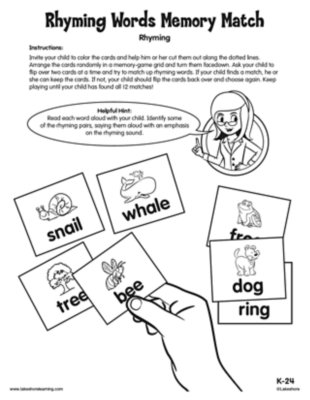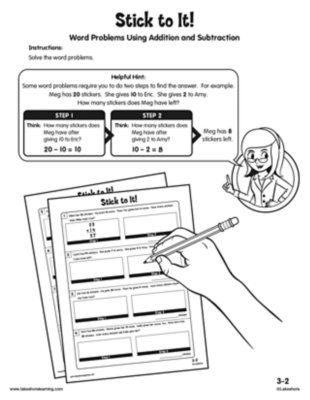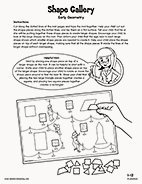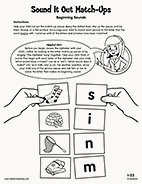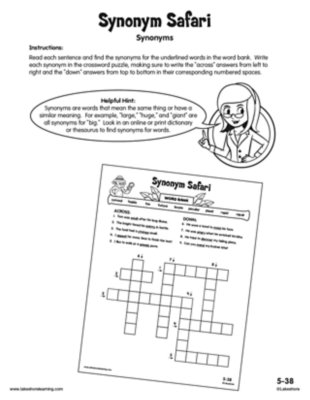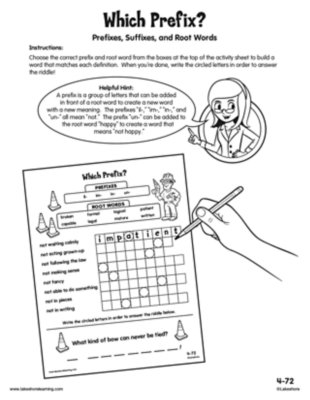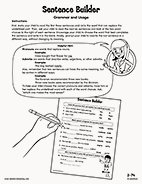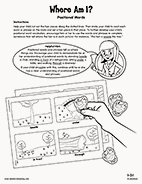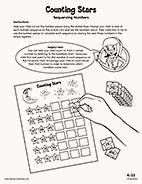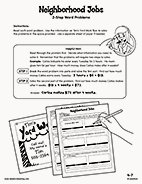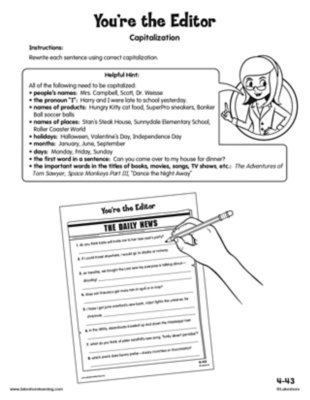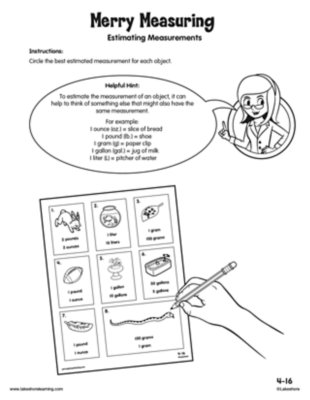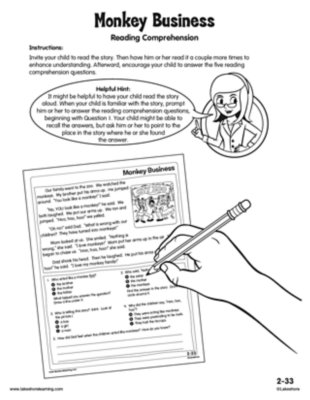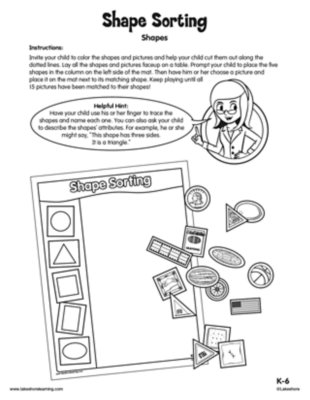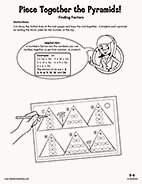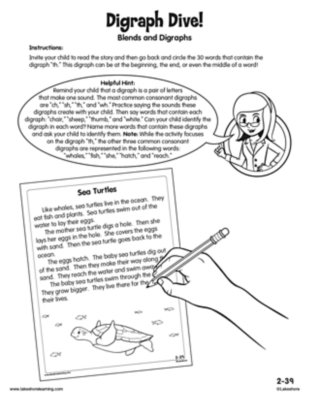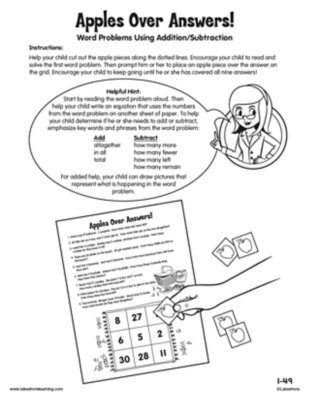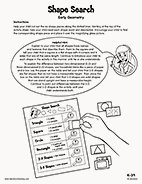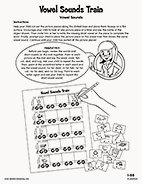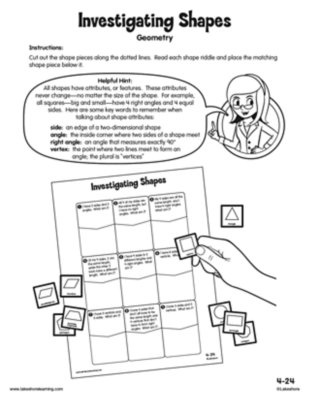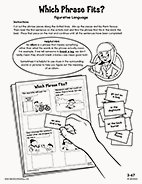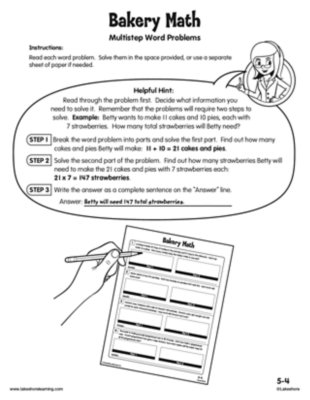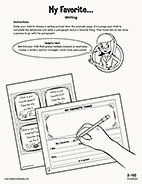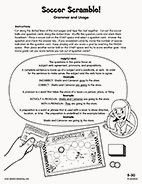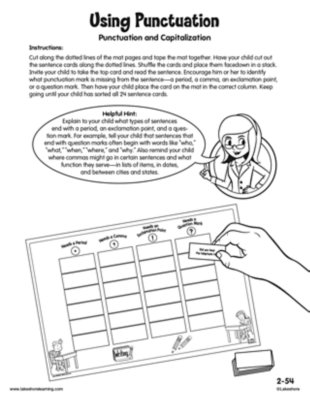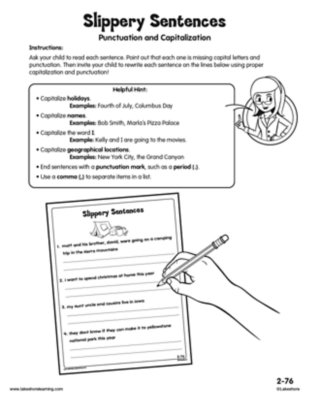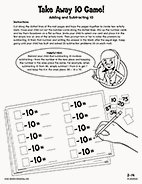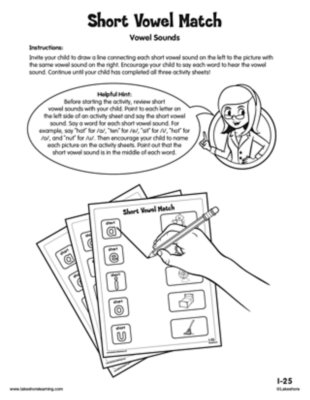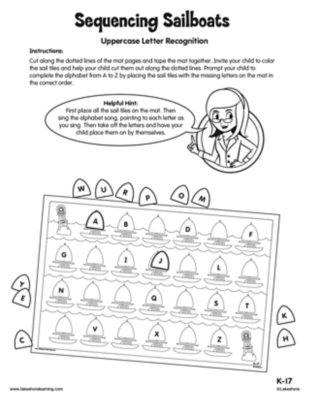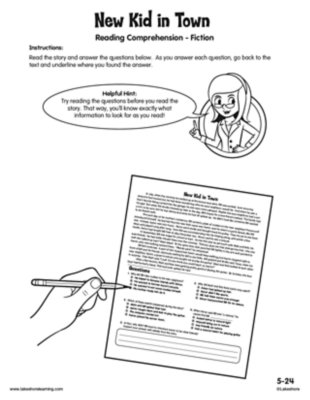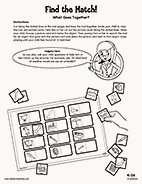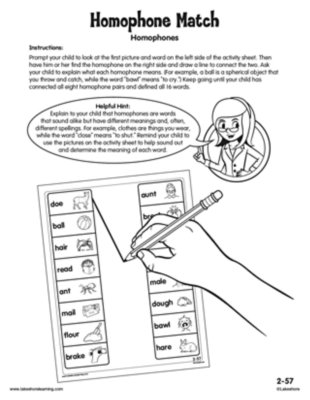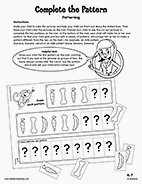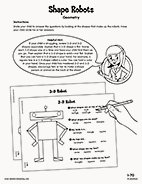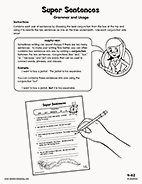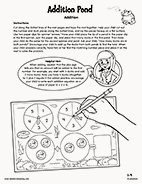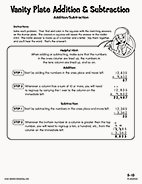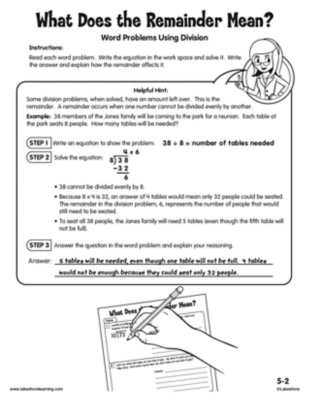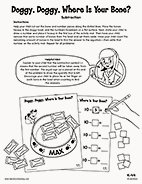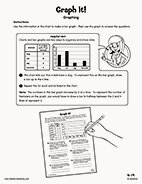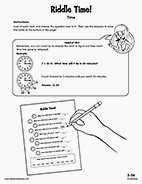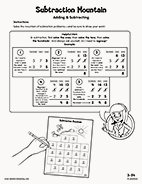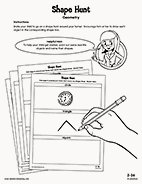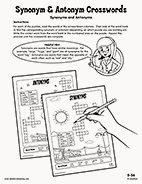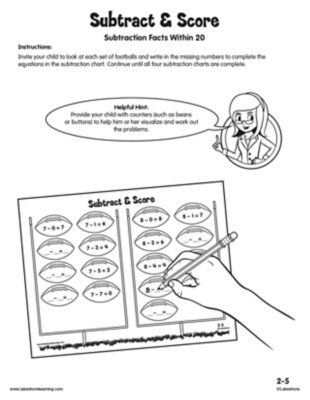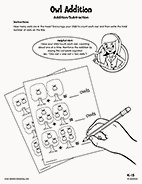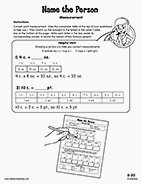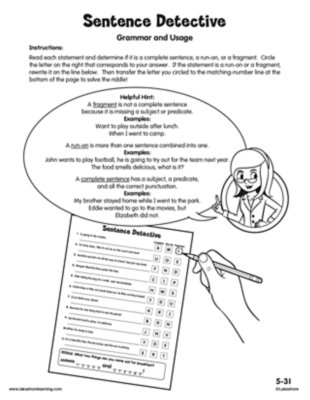
When entering fifth grade, your child should know how to correctly use words in sentences and should know many rules of English grammar and usage, including rules about relative pronouns (which, that), relative adverbs (where, when, why), the correct order of adjectives and more. Your child should also know how to use correct punctuation and capitalization when forming sentences and paragraphs.
View worksheetWhen entering first grade, your child should be able to read common, high-frequency words by sight, such as “the,” “of,” “to” and “you.”
View worksheetWhen entering kindergarten, your child should be able to recognize and name some lowercase letters, especially those in your child’s name.
View worksheetDuring first grade, your child will learn to tell and write time in hours and half-hours using clock faces and digital clocks.
View worksheetWhen entering kindergarten, your child should be able to describe the positions of objects and shapes using positional words and phrases, such as “in front of,” “behind,” “over,” “under” and “next to.”
View worksheetWhen entering second grade, your child should be able to define words by category and key attributes. For example, “A duck is a bird that swims.”
View worksheetDuring fourth grade, your child will learn to identify lines and angles, understand symmetry and classify shapes based on their lines and angles. For example, your child will be able to classify right triangles by seeing that they have a 90-degree angle.
View worksheetDuring first grade, your child will learn to figure out the meanings of new words and multiple-meaning words based on the context in which they are used.
View worksheetWhen entering third grade, your child should be able to use text features—including diagrams, bold print, glossaries and indexes—to locate facts in informational texts, such as newspapers, magazines or science books.
View worksheetWhen entering fifth grade, your child should be able to multiply a number with up to four digits by a one-digit number and a two-digit number by another two-digit number. Your child should also be able to divide numbers with up to four digits by a one-digit number, including problems with remainders.
View worksheetDuring kindergarten, your child will learn to add and subtract simple facts. For example, 3 + 7 = 10 and 10 — 5 = 5.
View worksheetWhen entering fourth grade, your child should be able to use bar graphs to solve one-step and two-step problems.
View worksheetWhen entering fourth grade, your child should be able to use clues within a sentence to figure out the meaning of an unfamiliar word or phrase. For example, in the following sentence, the underlined portion provides a clue to what the word “aviary” means: The zoo’s aviary was filled with owls, bluebirds, parrots, parakeets and cuckoos.
View worksheetWhen entering third grade, your child should be able to count and sequence numbers within 1,000 and skip-count by 5s, 10s and 100s.
View worksheetDuring third grade, your child will learn to easily add and subtract two 3-digit numbers, using regrouping when needed.
View worksheetDuring fifth grade, your child will learn to add and subtract decimals to the hundredths place. For example, 2.32 + 3.41 = 5.73.
View worksheetDuring fifth grade, your child will learn to read and write decimals in standard form, word form and expanded form to the thousandths place and round decimals to any place.
View worksheetWhen entering third grade, your child should be able to divide a rectangle into rows and columns of same-size squares and count to find the total number of them.
View worksheetDuring fourth grade, your child will read and analyze level-appropriate stories, dramas, poems and informational texts, exploring elements such as main ideas, key details, point of view, making inferences and the author’s purpose.
View worksheetWhen entering kindergarten, your child should be able to identify simple shapes—such as squares, circles, triangles and rectangles—and describe objects in the real world using shape names.
View worksheetWhen entering third grade, your child should be able to mentally add 10 or 100 to any given number from 100 to 900 without having to write down the problems and work them out. For example, 156 + 10 = 166 and 234 + 100 = 334.
View worksheetWhen entering second grade, your child should be able to see groups of tens and ones when counting. Your child should also understand that the two digits in a two-digit number represent tens and ones. For example, there are 3 tens and 2 ones in the number 32.
View worksheetDuring second grade, your child will learn to count and sequence numbers within 1,000 and skip-count by 2s, 5s, 10s and 100s.
View worksheetWhen entering first grade, your child should be able to form regular plural nouns when speaking by adding -s or -es. For example, “dog/dogs” and “wish/wishes.”
View worksheetDuring kindergarten, your child will learn that sentences begin with a capital letter and that the word “I” is also capitalized.
View worksheetDuring third grade, your child will learn to quickly and easily solve multiplication and division facts within 100 without having to count. For example, 9 x 9 = 81 and 56 ÷ 8 = 7.
View worksheetWhen entering fifth grade, your child should be able to read, analyze and understand level-appropriate stories, dramas and poems—exploring key events and details, analyzing characters, examining point of view and making inferences.
View worksheetDuring fifth grade, your child will learn to multiply and divide decimals to the hundredths place. For example, 212 x 0.45 = 95.40.
View worksheetWhen entering third grade, your child should be able to measure, estimate and compare the lengths of objects in standard units, such as inches, feet, centimeters and meters.
View worksheetDuring kindergarten, your child will learn to print uppercase and lowercase letters.
View worksheetWhen entering fifth grade, your child should be able to easily add and subtract multidigit whole numbers.
View worksheetWhen entering first grade, your child should be able to count to 100 by ones (1, 2, 3, 4…) and tens (10, 20, 30, 40…).
View worksheetDuring kindergarten, your child will learn to recognize and name the punctuation marks at the ends of sentences, including periods, question marks and exclamation points.
View worksheetDuring second grade, your child will learn to add and subtract within 1,000, using regrouping when needed. For example, 937 — 469 = 468.
View worksheetWhen entering second grade, your child should recognize and read common grade-appropriate sight-words and words with irregular spellings, such as “said,” “come” and “does.”
View worksheetDuring second grade, your child will learn to solve one- and two-step word problems involving addition and subtraction within 100.
View worksheetWhen entering first grade, your child should understand that sentences begin with a capital letter and that the word “I” is also capitalized. Your child should also be able to recognize and name the punctuation marks at the end of sentences, including periods, question marks and exclamation points.
View worksheetDuring fourth grade, your child will multiply a number with up to four digits by a one-digit number and multiply two-digit numbers by two-digit numbers. Your child will also divide numbers with up to four digits by a one-digit number, including solving problems with remainders.
View worksheetWhen entering fifth grade, your child should be able to use common, grade-appropriate Greek and Latin prefixes, suffixes and roots to figure out the meaning of a word. For example, “telegraph,” “photograph” and “autograph” all contain the Greek root “graph,” which refers to something that is written or drawn.
View worksheetDuring first grade, your child will learn what the equal sign means, identify whether equations are true or false and complete equations by finding missing numbers.
View worksheetDuring second grade, your child will learn to identify synonyms of words and use the synonyms in sentences.
View worksheetWhen entering fourth grade, your child should be able to read and analyze level-appropriate stories, dramas, poems and informational texts, identifying elements such as main ideas, key details and the author’s purpose.
View worksheetDuring third grade, your child will learn to capitalize the appropriate words in titles, such as the names of books and movies. Your child will also be expected to use commas in written addresses and with quotation marks to show when someone is speaking.
View worksheetDuring fifth grade, your child will learn to figure out the meaning of an unfamiliar word or phrase by using clues in the text, such as cause/effect relationships and comparisons. For example, in the following sentence, you can determine that the word “chastened” means “punished” by looking at the cause and effect: “When Judy found out that her son had cheated, she chastened him by taking away his video games.”
View worksheetWhen entering kindergarten, your child should be able to recognize and match words that rhyme.
View worksheetWhen entering third grade, your child should be able to solve one-step and two-step word problems involving addition and subtraction within 100.
View worksheetWhen entering first grade, your child should be able to identify 2-D (flat) and 3-D (solid) shapes, find shapes in the real world and compare shapes based on their number of sides or corners.
View worksheetWhen entering first grade, your child should be able to identify the beginning and ending sounds in simple words, such as identifying the “b” sound in “bat” or the “n” sound in “pen.”
View worksheetWhen entering fifth grade, your child should be able to understand words by relating them to their opposites (antonyms) and to words with similar but not identical meanings (synonyms).
View worksheetDuring fourth grade, your child will learn to use common, grade-appropriate Greek and Latin prefixes, suffixes and roots to figure out the meaning of a word. For example, “telegraph,” “photograph” and “autograph” all contain the Greek root “graph,” which refers to something that is written or drawn.
View worksheetDuring second grade, your child will learn many rules of English grammar and usage, including how to use adjectives and adverbs correctly, how to form and use contractions, and how to rearrange sentences to read correctly.
View worksheetWhen entering first grade, your child should be able to correctly use positional words, such as “above” and “between.”
View worksheetDuring kindergarten, your child will learn to count in sequence from 1 to 100 by ones (1, 2, 3, 4…) and tens (10, 20, 30, 40…).
View worksheetWhen entering fourth grade, your child should know how to solve two-step word problems involving addition, subtraction, multiplication and division.
View worksheetWhen entering fourth grade, your child should remember to capitalize the appropriate words in titles, such as the names of books and movies. Your child should also remember to use commas in written addresses and with quotation marks to show when someone is speaking.
View worksheetWhen entering fourth grade, your child should be able to estimate liquid volumes and masses of objects using grams, kilograms and liters.
View worksheetWhen entering second grade, your child should be able to recall and identify key events, facts and details in grade-appropriate fiction and nonfiction texts.
View worksheetWhen entering kindergarten, your child should be able to identify simple shapes—such as squares, circles, triangles and rectangles—and describe objects in the real world using shape names.
View worksheetWhen entering fifth grade, your child should be able to identify whether a number is prime or composite and find all the factor pairs for a whole number between 1 and 100. Factors are the numbers that can be multiplied together to reach another number. For example, the factor pairs for 6 are 1 and 6 (because 1 x 6 = 6) and 2 and 3 (because 2 x 3 = 6).
View worksheetWhen entering second grade, your child should be able to read and spell words with consonant blends, such as “st,” “sp” and “bl,” as well as common consonant digraphs, such as “th,” “ch” and “sh.”
View worksheetDuring first grade, your child will be asked to solve word problems that involve adding and subtracting within 20.
View worksheetDuring kindergarten, your child will learn to identify 2-D (flat) and 3-D (solid) shapes, find shapes in the real world and compare shapes based on their number of sides or corners.
View worksheetDuring first grade, your child will learn to distinguish between short and long vowels in spoken one-syllable words, such as the short “a” in “cap” and the long “a” in “cape.” Your child will also learn that final -e and common vowel teams can be used to make long vowel sounds, such as the long “o” in “rope” and “coat.”
View worksheetWhen entering fourth grade, your child should understand that different types of shapes can share the same attributes. For example, rhombuses, rectangles and squares all have four sides and are part of a larger group called quadrilaterals.
View worksheetDuring third grade, your child will learn to understand figurative language, such as idioms, and distinguish between the literal and nonliteral meanings of words. For example, “It was a piece of cake!”
View worksheetWhen entering fifth grade, your child should be able to solve multistep word problems using addition, subtraction, multiplication and division, including problems with remainders.
View worksheetWhen entering second grade, your child should be able to write short opinion pieces, informative texts and narratives (stories).
View worksheetWhen entering fifth grade, your child should know how to correctly use words in sentences and should know many rules of English grammar and usage, including rules about relative pronouns (which, that), relative adverbs (where, when, why), the correct order of adjectives and more. Your child should also know how to use correct punctuation and capitalization when forming sentences and paragraphs.
View worksheetWhen entering second grade, your child should remember to capitalize dates and people’s names. Your child will also be expected to use punctuation at the ends of sentences. Your child should also use commas in dates and to separate words in a series. For example, “I like apples, bananas, and strawberries.”
View worksheetDuring second grade, your child will learn to capitalize holidays, product names and geographic names. Your child will also learn to use commas in the greetings and closings of letters and use apostrophes in contractions and possessives, such as “Jeff’s bike.”
View worksheetWhen entering second grade, your child should be able to mentally add 10 to or subtract 10 from any two-digit number—without having to count. For example, 32 + 10 = 42 and 35 — 10 = 25.
View worksheetWhen entering second grade, your child should understand that addition and subtraction are related. Your child should also be able to determine the missing number in an addition or subtraction equation. For example, 6 + __ = 8.
View worksheetWhen entering first grade, your child should know the long and short vowel sounds for the five major vowels (a, e, i, o and u).
View worksheetWhen entering kindergarten, your child should be able to recognize and name some uppercase letters, especially those in your child’s name.
View worksheetWhen entering fifth grade, your child should be able to read, analyze and understand level-appropriate stories, dramas and poems—exploring key events and details, analyzing characters, examining point of view and making inferences.
View worksheetWhen entering fourth grade, your child should understand figurative language, such as idioms, and be able to distinguish between the literal and nonliteral meanings of words. For example, “It was a piece of cake!”
View worksheetWhen entering kindergarten, your child should be able to group common objects into categories and identify reasons for grouping the objects. For example, if given a lamp, sofa and zebra, your child should be able to group the lamp and sofa together because they are household items, while the zebra is not.
View worksheetWhen entering second grade, your child should be able to figure out the correct meanings of grade-appropriate homophones—words that sound the same but have different meaningss. For example, “to” and “two” or “eye” and “I.”
View worksheetWhen entering kindergarten, your child should be able to copy simple patterns, such as ABAB, and determine what comes next in the pattern.
View worksheetWhen entering third grade, your child should be able to solve problems using information from line plots, picture graphs and bar graphs.
View worksheetDuring first grade, your child will learn the attributes of many shapes—such as the fact that a triangle has three sides—and how to divide circles and rectangles into halves and fourths. Your child will also be asked to find shapes within shapes, such as turning a square into two triangles by drawing a line from one corner to the opposite corner.
View worksheetDuring fourth grade, your child will learn many new rules of English grammar and usage, including rules about sentence fragments and run-on sentences, relative pronouns (which, that), relative adverbs (where, when, why), the correct order of adjectives and more.
View worksheetWhen entering first grade, your child should be able to add and subtract simple facts. For example, 3 + 7 = 10 and 10 — 5 = 5.
View worksheetWhen entering fifth grade, your child should be able to easily add and subtract multidigit whole numbers.
View worksheetWhen entering fifth grade, your child should be able to multiply and divide to solve word problems and be able to solve multistep word problems that involve multiplication and division.
View worksheetDuring kindergarten, your child will learn to add and subtract simple facts. For example, 3 + 7 = 10 and 10 — 5 = 5.
View worksheetWhen entering fourth grade, your child should be able to use bar graphs to solve one-step and two-step problems.
View worksheetWhen entering fourth grade, your child should be able to use clues within a sentence to figure out the meaning of an unfamiliar word or phrase. For example, in the following sentence, the underlined portion provides a clue to what the word “aviary” means: The zoo’s aviary was filled with owls, bluebirds, parrots, parakeets and cuckoos.
View worksheetDuring third grade, your child will learn to tell and write time to the nearest minute. Your child will also learn to solve problems in which time has elapsed. For example, “The movie started at 5:15 p.m. It was 1 hour and 20 minutes long. What time did the movie end?”
View worksheetDuring third grade, your child will learn to easily add and subtract two 3-digit numbers, using regrouping when needed.
View worksheetWhen entering kindergarten, your child should be able to compare objects and describe their similarities and differences, including distinguishing by color, size, weight or shape. Your child should also be able to describe objects using the correct words, such as “big,” “small,” “short” and “tall.”
View worksheetWhen entering second grade, your child should understand the attributes of different shapes—such as a triangle’s three sides—and be able to draw a variety of 2-D shapes.
View worksheetDuring fifth grade, your child will learn to use the relationship between synonyms (words with similar meanings) and antonyms (opposites) to better understand each of the words.
View worksheetWhen entering second grade, your child should be able to subtract within 20 fluently. For example, 18 — 5 = 13 and 20 — 6 = 14.
View worksheetWhen entering kindergarten, your child should be able to perform simple addition and subtraction using objects or their fingers. For example, “If we have 3 apples and add 2 more, how many apples do we have altogether?”
View worksheetWhen entering fifth grade, your child should be able to solve problems involving measurement and conversion of measurement.
View worksheet
